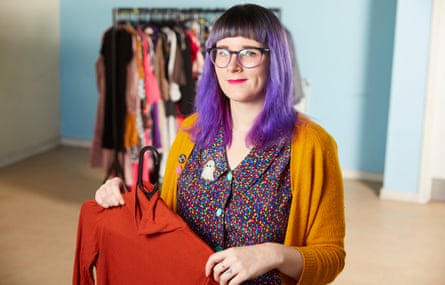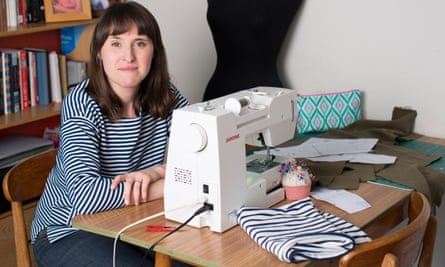Lauren Cowdery is flicking through the rails of the Cancer Research charity shop in Goole, east Yorkshire. “Too bobbly!” she tuts at a ribbed top. “This skirt is big but it would be easy to take in … ” Cowdery appears to be shopping, but she is merely browsing. She is on a mission not to buy any new clothes, even ones that have recently belonged to someone else. “I think you have to pull back and ask: ‘Do I need this?’” she says.
The Guardian’s product and service reviews are independent and are in no way influenced by any advertiser or commercial initiative. We will earn a commission from the retailer if you buy something through an affiliate link. Learn more.
Cowdery is one of a growing number of people who love clothes but try their hardest to resist buying them for reasons of sustainability. According to the charity Wrap, which promotes sustainable waste management, the average lifetime for a garment in the UK is just 2.2 years. An estimated £30bn of unused clothing hangs in UK wardrobes, and yet still we shop for more. “Each week we buy 38m items and 11m items go to landfill,” says Maria Chenoweth, chief executive of Traid, a charity working to stop clothes being thrown away. “We don’t have enough resources to keep feeding this monster.”
Chenoweth believes that consumers are switching to secondhand shopping, or adding a pre-owned element into their purchasing habits. She points to a 30% rise in turnover at Traid shops in 2018 compared with 2017. When she was a teenager in the 80s, her father banned her from jumble sales in case people thought the family was poor. She disobeyed him, and dragged her sacks of clothes through her bedroom window. Now, Chenoweth considers it “a huge gesture of activism to buy secondhand”, a necessary choice for those who “do not believe in damaging the environment and perpetuating this consumption and waste”.
So how hard is it to make the transition to a more sustainable way of shopping? In the UK, clothing has the fourth largest environmental impact after housing, transport and food. More than half of fast-fashion items are thrown away in less than a year, according to McKinsey’s State of Fashion report last year. But is buying secondhand really an antidote to fast fashion?
In Goole, where Cowdery works as a marketing officer for the Junction Theatre, there are ample local distractions for a lunch break: Dorothy Perkins, New Look, Peacocks. Cowdery used to buy things “because they were there”. In the evenings, she went on Asos. “I’d think: ‘Oh brilliant, a discount code! Free shipping! I’ll order stuff! Hmm … It doesn’t fit very well, but I can’t be bothered to send it back … I’ll keep it.’”
Each month, Cowdery bought two or three things. “At £20 a time, that starts to build up. There’s a wardrobe of stuff. Things with the tags still on … I took a look at myself and thought: ‘What are you doing?’”

Curious about a post she saw on Facebook, one weekend Cowdery dropped into the Leeds Community Clothes Exchange, a local swap shop. Four years on, she is one of its three directors, helping to oversee the 2,000 items – “designer stuff, vintage stuff, handmade things, wedding dresses” – that pass through the doors of the Woodhouse community centre each month.
Cowdery and I meet in one of those lunch hours that used to be spent shopping. Her skirt, top and cardigan are all from the Clothes Exchange; her boots are from the Autism Plus shop in Goole. “At the exchange, it’s one for one on everything,” she explains. There are no value judgments. A garment is saleable if all its buttons are present and there are no stains. Some prom dresses return again and again. “People take them, wear them, bring them back.” Regulars set aside pieces for each other. The fitting room is a place of encouragement.
As her involvement in the clothes exchange grew, Cowdery’s visits to Peacocks dwindled. Now, its shop floor struck her as “an explosion in a jumble sale”. She began to delete unopened emails from Asos and Topshop. She swore off buying new clothes for a year. “I thought I’d reach the end and think: ‘I’ve done that. I’ll move on,’” she says. Instead, “It changed how I thought about clothes.”
Cowdery still loves clothes – especially anything velvet – but she has found a safe way to consume them. The clothes exchange enables her to refresh her wardrobe without adding to it. She can be acquisitive, as long as she relinquishes in equal measure. Where she once bought three pieces a month, she now swaps 10 to 15 – mostly things she picked up at the previous exchange.
Clothes come and go at the Basingstoke home of Sarah Fewell, too. In fact, so many parcels come and go that she knows her postman by his first name (Jay). Fewell has always loved cutting up old clothes, sticking on studs, even at 14 when most of her friends were into Hollister. But now she has turned her passion for preloved clothes into a sustainable version of fast fashion.
Fewell runs a shop called Identity Party on the website Depop, which since being established in 2011 has offered its 10 million users a blend of eBay-style trading with Instagram-style posting. Her brand is “a lot of 80s, 90s, quite bohemian, grungy”. She especially loves “selling things with animals on, a good old ugly jumper and anything by St Michael.”
Two years ago, in the second year of a politics degree at Goldsmiths, University of London, Fewell was browsing the charity shops when she saw “a really nice dress that wasn’t for me”. She already had a Depop profile, having sold some unwanted clothes, so she bought the dress, listed it as “‘very Phoebe from Friends” and it promptly sold.
She bought and sold relentlessly during her third year. “When I left university, I thought, I don’t want a real job.”
Now with Identity Party, Fewell has professionalised her love of vintage.
She doesn’t totally eschew new clothes for her own wardobe; they make up about 10%. She buys gymwear new, for instance (“It would be a bit gross to wear secondhand gym clothes”). She even bought some on Black Friday: “That’s maybe contradictory of me to engage in Black Friday, but I just wanted gym clothes.”
People used to watch hauls on YouTube and be like: ‘Yeah, great.’ Now they are a lot more aware
We are sitting in a cafe in a shopping mall in Basingstoke. Fewell, who is wearing an Identity Party top and jeans and an eBay jacket, runs through her working week: Monday, she posts; Tuesday, she photographs; Wednesday she uploads. A fourth day is spent scouring the charity shops of Basingstoke, Newbury and Reading. A fifth and a sixth on further photography and posting.
Fewell’s days are long. But all the hours spent cutting out shoulder pads and removing used handkerchiefs from pockets have made her one of Depop’s top sellers. Since that first dress, she has sold more than 3,000 items, and her customer base includes her own friends, who no longer find secondhand shopping “a bit niche”.
“A lot of people are getting really sick of fast fashion,” Fewell says. “People used to watch hauls [mass trying-on sessions of newly purchased clothing] on YouTube and be like: ‘Yeah, great.’ Now if you click on a haul and read the comments, everyone’s like: ‘Oh, there’s so much stuff, it looks really bad quality.’ People are a lot more aware.”
In 2017, when she posted that first dress, Fewell “wasn’t very conscious” of the sustainability benefits of secondhand clothing. “I wasn’t really thinking: ‘I could push this message.’” After a couple of months, “it got added in there”. Now she trades her “handpicked vintage gems” as sustainable fashion. Facts about clothing waste are printed on the reverse of her business cards. When a piece of clothing doesn’t suit a customer, she urges them to sell it on, to close the loop.
But does Fewell ever look at the floor of her parents’ spare room – now her stock room – at the sea of pink plastic packages waiting to be driven to the post office, and think that buying and selling secondhand clothing may not be the height of sustainability? In some ways, Depop mirrors fast fashion: consumers buy cheaply and often. Fewell points out that the bags are made of recycled plastic; she would like to afford biodegradable ones. “The downside, environmentally, is postage and packing,” she admits. “But people are always going to want to buy clothes. Buying secondhand is probably the best way they can do it.”
The key, says Stephanie Campbell from Wrap’s Love Your Clothes campaign, is “to keep clothing out of landfill”. Each year 430,000 tonnes of clothing are disposed of and not recycled in the UK. Meanwhile, the number of new clothes sold is rising: 1.13m tonnes in 2016, an increase of 200,000 tonnes on 2012.

“It’s a slow, gradual mindset change,” says Zoe Edwards, a sewing teacher and blogger who 11 years ago pledged never to buy new clothes. “It’s not like a switch goes on and all of a sudden, it’s: ‘Right, this is how I shop now.’”
Edwards was working for “a very fast-fashion, low-end clothing supplier” in London. Her job was to order the trims: labels, hanging loops, buttons, zips. The quantity of delivered fabric always varied, so she had to order a surfeit of trims, a routine waste that made her uncomfortable. She had always loved sewing, selling her handmade clothes on market stalls and Etsy. Now, her two ways of living jarred.
“I didn’t want to be part of fast fashion any more,” she says. She quit her job, sewed clothes, sold the clothes, taught sewing and blogged about it. In the past 11 years, Edwards has bought only “one or two things”. Her bras are new, and she thinks she may have purchased a top from Zara in about 2010. Even her knickers are what she calls “me-made”.
So how difficult is it to stop buying clothes? Tania Arrayales, a self-described “fashion disruptor”, has founded an organisation in New York called Fashion of Tomorrow to advocate a more sustainable approach to the clothing industry. Arrayales was a founding member of Style Lend, a peer-to-peer clothing rental site, and swore off all clothing purchases for a year, inspired by the documentary True Cost. But weren’t there times when she was desperate to break her self-imposed rule?
“The challenge was feeling a little bit … I wasn’t as trendy as I used to be. I couldn’t make an impact when I went to an event,” she says. “I didn’t have anything new and shiny. But I wanted to restructure the way my brain saw shopping.”

In her second year, she allowed herself to buy vintage clothes. The year after that, she bought the odd piece of new clothing from sustainable brands. Any time she felt her style “lack a little”, she rented what she needed from Style Lend (there are lending sites in the UK, too, but this is not yet a flourishing market). “I started seeing pieces in a new light. I discovered styling,” Arrayales says.
Cowdery has noticed a similar sense of exploration and play at the Clothes Exchange. “I’ve been more experimental, more free, with clothes. I don’t keep things for best. I wear them. And I don’t worry about the size on the label,” she says.
The fluidity around sizing is one of the pleasures of secondhand shopping. Depop sellers such as Fewell list clothes as fitting size eight to 14. Shoppers are encouraged to view their size as variable. “That’s the great thing about swapping,” Cowdery says. No one gets depressed because something their size won’t zip up. “You just look by eye, and ask yourself: ‘Will that fit?’”
Edwards has faced a similar confrontation with her personal taste. Sewing requires a lot of decision-making: the colour and weight of fabric, length of dress, shape of sleeves. She buys vintage fabric and refashions charity shop finds, but even so, she doesn’t think “sewing is necessarily the most sustainable way to dress yourself”. There is still the acquisition of fabric and materials. And a tendency to prize the making over the wearing, so that a lot of making goes on that never gets worn. “There is a big slow fashion movement within the sewing community,” Edwards says. “People are using their stash rather than buying new stuff.”
The volume of clothing of all kinds – new, secondhand and handmade – is challenging. And selling on secondhand clothes has its limits. To avoid swamping the secondhand market, or passing the problem on to others, including developing countries where many used clothes are sold in bulk, other technologies, such as fibre-to-fibre recycling, need to be encouraged.
“Clothing is a way to show who I am, what I feel, what I believe,” Edwards says. “It’s a way to communicate with the world. It’s got real social value, but it has got to be done mindfully.”
So what can a person who loves new clothes but wants to live more sustainably do? As Edwards says, if you are spending time on fashion sites, it doesn’t take a huge leap of imagination or will to switch your browser to eBay, Depop, thredUP, HEWI London or any of the raft of “resale disruptors”. Chenoweth says that “not keeping stuff in your wardrobe is important if you’re not wearing it”. Donating clothes puts them back into circulation.
As Cowdery says: “Clothes have a story. If you wear something once then throw it in the bin, it hasn’t had a story. You want to know there’s life in these things.”

Comments (…)
Sign in or create your Guardian account to join the discussion